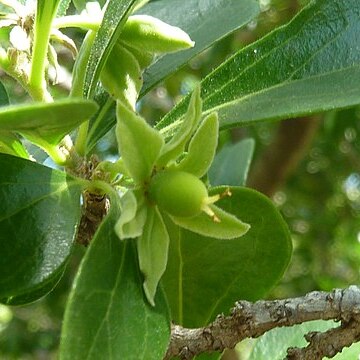It can be a shrub 1.5 m tall or a tree 12 m tall. It can give off a strong smell like rotten meat. There are short sharp straight spines up to 2.5 cm long in the axils of leaves. Leaves are simple and alternate. They vary in shape and texture. Leaves are 1.3-7 cm long by 1.3-4 cm wide. The young leaves are soft and velvety. The flowers are small and pale green and male and female flowers are separate. The male flowers are in small clusters in the axils of leaves and female flowers occur singly often on small side shoots. The fruit is an oval berry. It has a persistent style at the tip. Fruit are orange-yellow when ripe. The fruit are 2 cm long and with 2-3 seeds. The fruit are edible.
Tree or shrub, 1.5-11.0 m high, dioecious, often armed with pubescent or glabrous spines. Leaves alternate, petiolate; obovate to rhomboid-elliptic, blade thin and soft, sometimes coriaceous when mature, 3-veined from base, margins entire to crenate. Male flowers in fascicles of 3-6, pedicellate; calyx 4-6-lobed; corolla absent; stamens 24-48. Female flowers solitary, pedicellate; calyx 4-7-lobed, lobes lanceolate-obovate; corolla absent; styles 2 or 3; ovary 2-or 3-lobed, almost completely 2-or 3-locular, placentas 2 or 3, each with 1 ovule. Flowering time Sept.-Jan. Fruit oblong berry, densely and shortly hairy, orange to red.
Leaf-lamina 1.5–6 x 1–3.5 cm., obovate to broadly elliptic, apex rounded, mucronate or occasionally refuse, cuneate at the 3-nerved base, margin remotely crenulate or subentire, often somewhat revolute, both sides pubescent or more rarely glabrous, the margins or at least the crenatures often ciliate-pubescent, with a pair of lateral nerves arising from the midrib some 5 mm. above the base noticeably stronger and more prominent than the remainder and subparallel with the margins, petiole up to 8 mm., ± pubescent.
Male flowers in axillary fascicles of 2–4; pedicels 4–7 mm. long, densely pubescent; calyx of 5 (6) lobes, divided almost to the base, lobes c. 6 x 2.5 mm., oblong-lanceolate to ovate-lanceolate, acute at the apex, densely pubescent to tomentose on both sides; stamens c. 40 on glabrous filaments c. 4 mm. long; inter-staminal glands 0–5 mm. long, obovoid, densely setulose-ciliate.
Female flowers solitary; calyx lobes 5–7 (8), broader than in the male, ovate-lanceolate; annular disk with short, rounded, villous lobes alternating with the sepals; ovary narrowly ovoid, densely but shortly tomentose; styles 2–3, 1.5–2 mm. long, divergent, pubescent, stigmas broadly bilobed.
Shrub or tree up to about 10 m. tall, sometimes armed with straight spines up to about 2.5 cm. long or rarely more, branches with a pale grey bark, often rough with pale lenticels, young branchlets with patent yellowish hairs or occasionally practically glabrous.
Fruit c. 2 x 1.3 cm., densely and shortly golden-tomentose, ellipsoid, fleshy, 2–3-seeded.


